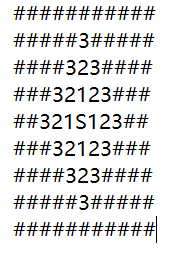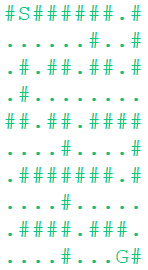版权声明:本文为博主原创文章,未经博主允许不得转载。 https://blog.csdn.net/c_yejiajun/article/details/86655430
宽度优先搜索
迷宫最短路径用宽度优先搜索(bfs)相比用深度优先搜索(dfs)的好处在于bfs每次计算都是最短路径不存在重复计算,而dfs每计算出一条可行的路径都要与先前的路径比较,然后储存最短路径。
而bfs的思想是先计算出围绕起点的所有点的距离并储存起来

S是起点,数字为该点到S的距离
根据该思想为下题写一段程序
在N*M的迷宫中,计算出S到G的最短路径
‘#’,’.’, ‘S’, 'G’分别表示墙壁、通道、起点、终点
代码如下:
import java.util.LinkedList;
import java.util.Queue;
import java.util.Scanner;
public class Main {
public static void main(String[] args) {
Scanner sc = new Scanner(System.in);
int n = sc.nextInt();
int m = sc.nextInt();
String t = sc.nextLine();
char [][] map = new char [n][m];
int[] begin = new int [2];
int[] end = new int [2];
for(int i = 0; i < n; i++) {
String s = sc.nextLine();
map[i] = s.toCharArray();
if(s.contains("S")) {
begin[0] = i;
begin[1] = s.indexOf("S");
}
if(s.contains("G")) {
end[0] = i;
end[1] = s.indexOf("G");
}
}
System.out.println(bfs(map, begin, end));
}
public static int bfs(char [][] map, int [] begin, int [] end) {
//移动的四个方向
int[] dx = {1, 0, -1, 0};
int[] dy = {0, 1, 0, -1};
//用来储存距离到起始点最短路径的二维数组
int[][] d = new int [map.length][map[0].length];
//储存未进行处理的点
Queue<int []> que = new LinkedList<int []>();
//将所有的位置都初始化为最大
for(int i = 0; i < d.length; i++) {
for(int j = 0; j < d[0].length; j++) {
d[i][j] = Integer.MAX_VALUE;
}
}
//将起始点放入队列
que.offer(begin);
//将起始点最短路径设为0
d[ begin[0] ][ begin[1] ] = 0;
//一直循环直到队列为空
while(!que.isEmpty()) {
//取出队列中最前端的点
int [] current = que.poll();
//如果是终点则结束
if(current[0] == end[0] && current[1] == end[1]) break;
//四个方向循环
for(int i = 0; i < 4; i++) {
//试探
int ny = current[0] + dy[i];
int nx = current[1] + dx[i];
//判断是否可以走
if(ny >= 0 && ny < d.length && nx >= 0 && nx < d[0].length && map[ny][nx] != '#' && d[ny][nx] == Integer.MAX_VALUE) {
//如果可以走,则将该点的距离加1
d[ny][nx] = d[current[0]][current[1]] + 1;
//并将该点放入队列等待下次处理
int[] c = {ny, nx};
que.offer(c);
}
}
}
return d[end[0]][end[1]];
}
}
